Key takeaways:
- Empowering children by educating them about their rights fosters confidence and supports the safeguarding process.
- Effective policy implementation is critical to build trust and ensure children feel secure; communication and clarity among staff are essential.
- Regular training, stakeholder involvement, and feedback loops are vital for adapting policies and enhancing their effectiveness.
- Engaging families in the safeguarding process creates a supportive environment and addresses concerns about reporting issues.

Understanding child safeguarding principles
Understanding child safeguarding principles is fundamental to creating a safe environment for children. As I reflect on my experiences in this field, I often wonder how many adults truly grasp the weight of their responsibility. It’s not just about compliance; it’s about intertwining these principles into our daily interactions with children, ensuring that they feel valued and respected.
One principle that resonates deeply with me is the idea of empowering children to understand their rights. I remember working with a young girl who once felt scared to speak up about inappropriate behavior from a peer. When we equipped her with knowledge about her rights, I witnessed her transform. This empowerment not only built her confidence but also reinforced her understanding of what safeguarding truly means—honoring her voice and choices.
At the heart of safeguarding is the commitment to a child-centered approach. Have you ever paused to think about how your actions might affect a child’s sense of safety? Personally, I’ve found that listening to children’s stories, no matter how small they may seem, can validate their feelings and experiences. Such moments remind me that safeguarding is not merely a policy; it’s a heartfelt promise to uphold the dignity and well-being of every child.
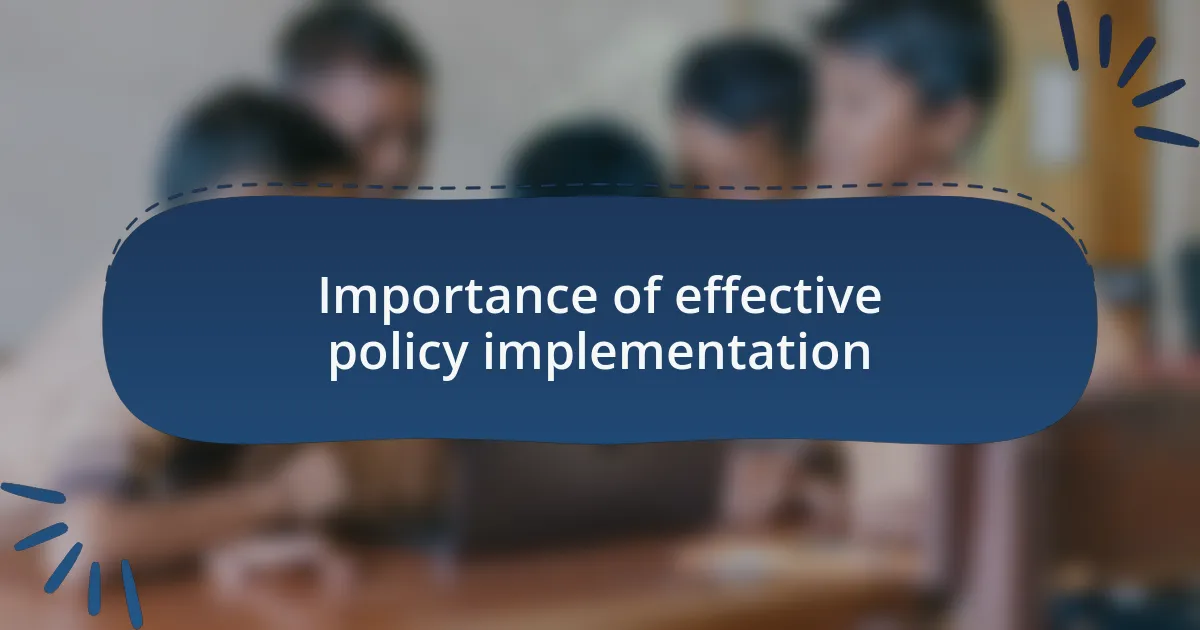
Importance of effective policy implementation
Effective policy implementation is crucial because it translates intention into action. I recall a situation where a well-intentioned policy aimed at improving child safety was inadequately implemented. The lack of clear communication with staff resulted in confusion and ultimately a missed opportunity to protect a vulnerable child. It really hit home for me how vital it is to ensure that everyone involved understands their role in carrying out these policies.
Moreover, the emotional connection we foster when policies are implemented effectively can significantly impact the lives of children. I once attended a training session where we discussed a new reporting procedure. The clarity and teamwork that emerged from that session led to immediate improvements in our response times when children needed help. It reinforced my belief that effective implementation isn’t just about rules; it’s about creating a culture of care and responsiveness.
Additionally, consider the message we send to children when policies are not effectively enforced. I remember observing a child’s disillusionment when the protective measures we had in place failed to safeguard him in a critical moment. It made me realize that weak policy implementation can erode trust, leaving children feeling unsafe and unheard. That’s why it’s essential not just to have policies, but to ensure they’re executed properly, so children feel secure and supported in their environment.
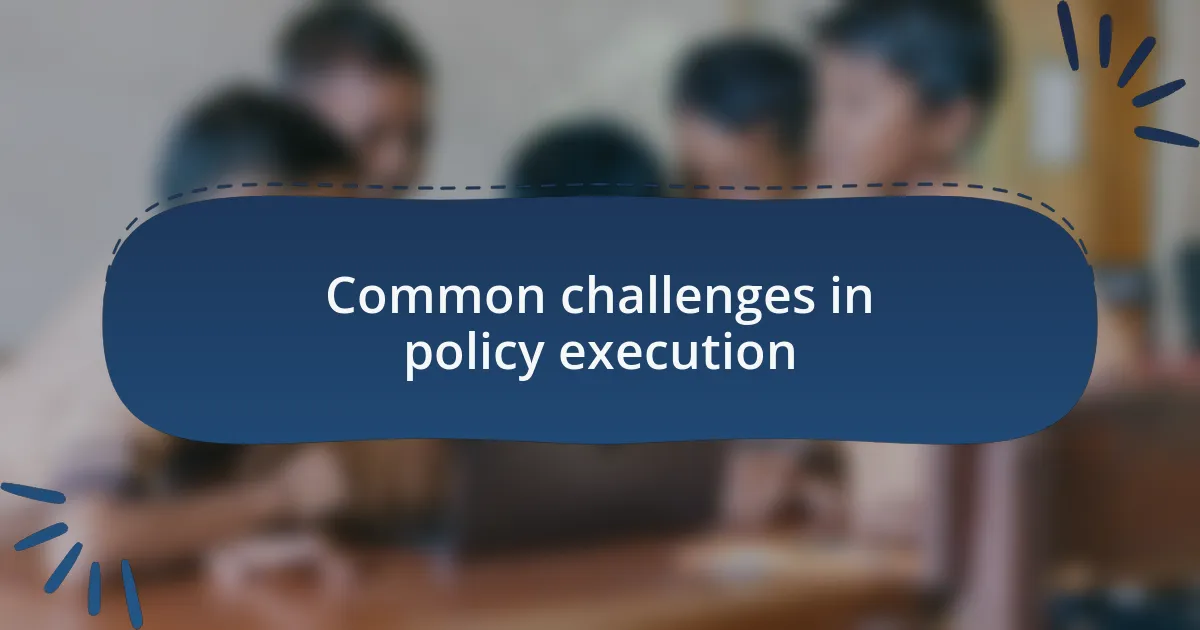
Common challenges in policy execution
When it comes to executing policies, one of the most common challenges I have seen is a lack of resources. I recall a project where we aimed to implement new training modules for staff, but without adequate funding, many employees never received the necessary training. This left gaps in knowledge and skills that ultimately affected the entire system. How can we expect policies to be followed effectively if the very foundation—our resources—is shaky?
Another hurdle I’ve encountered is the resistance to change within organizations. I’ve witnessed firsthand how some staff members were hesitant to adopt new procedures, viewing them as burdens rather than improvements. It made me think: what drives this resistance? Often, it’s fear of the unknown or a belief that existing methods are sufficient. Addressing these feelings requires patience and understanding, and in these moments, I’ve learned that open dialogue can bridge the gap between apprehension and acceptance.
Communication breakdown is perhaps the most insidious challenge I have faced. There was a time when a new child protection policy was rolled out, but essential information was not shared promptly with frontline workers. I remember the confusion it caused—they were unsure about their responsibilities. This situation left some vulnerable children without the protection they needed. It really made me question: how can we create a supportive environment without clear communication? The answer lies in establishing regular updates and feedback loops, ensuring that everyone is on the same page and fully engaged in the safeguarding mission.
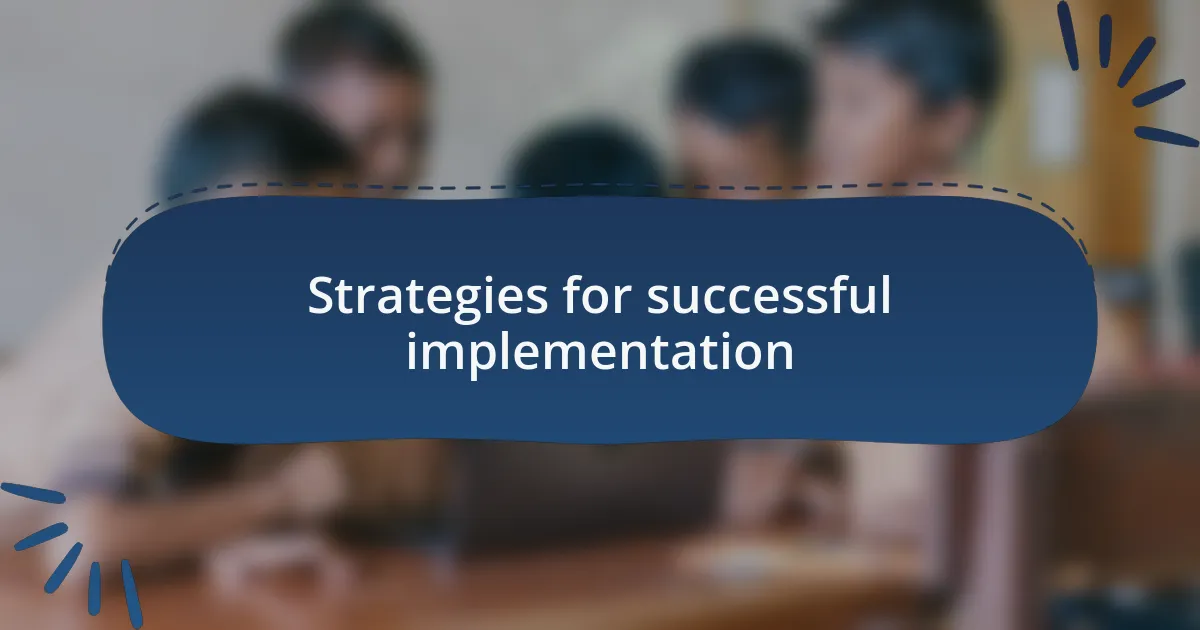
Strategies for successful implementation
One effective strategy I’ve found in my experience is prioritizing training for all staff involved in policy implementation. I recall participating in a workshop where we ignited enthusiasm among the team through hands-on activities. This approach not only clarified the policies but also fostered a deep understanding of their significance. How can we expect shared responsibility if the team isn’t well-equipped with the knowledge to act?
Involving stakeholders early in the process can dramatically enhance commitment. I once collaborated with local parents and community leaders during the rollout of a child safeguarding initiative. Their insights offered invaluable perspectives that shaped our approach, and I noticed a palpable shift in ownership and support. Isn’t it powerful to think that our community’s voices can guide effective strategies? Engaging diverse viewpoints can transform a policy from a document into a shared vision.
Regular evaluations are crucial, as they allow us to identify gaps and assess the effectiveness of our strategies. I’ve seen how implementing quarterly reviews led to real-time adjustments that made our policies more relevant. This iterative process fosters a culture of accountability and continuous improvement. How can we grow if we don’t take the time to reflect and adapt? Embracing this idea is essential for truly successful policy implementation.
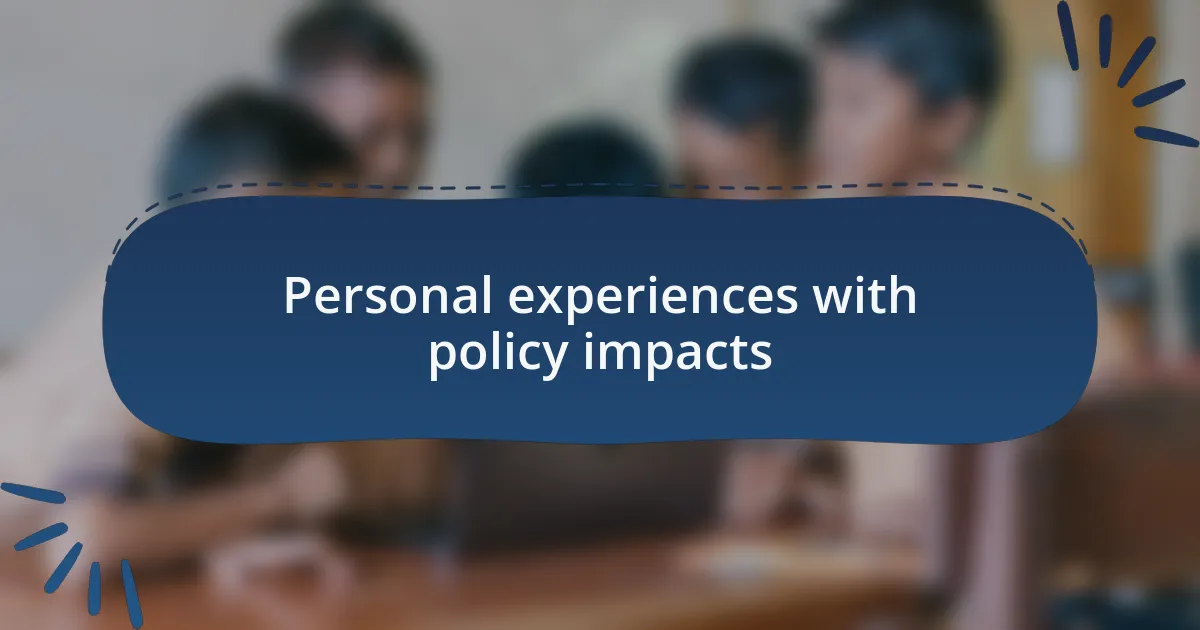
Personal experiences with policy impacts
Reflecting on my experiences, I remember how the introduction of a new child safeguarding policy radically transformed our approach to care. During a critical meeting, we discussed the policy’s implications, and I could feel the tension as some team members expressed doubts. However, once we witnessed the positive outcomes in our interactions with children and families, those concerns faded, replaced by a motivated team genuinely invested in the changes. Isn’t it amazing how policy can shift mindsets and behaviors in such profound ways?
One specific moment that stands out to me was when we had to implement a reporting protocol for safeguarding concerns. Initially, it felt cumbersome and intimidating to some staff members. However, as we navigated through real cases together, I saw a remarkable shift. Staff began to share their experiences and fears, fostering a supportive environment where everyone felt empowered to speak up. How transformative can a shared experience be when dealing with sensitive topics?
Interestingly, the impact of policy doesn’t just stay with the staff; it resonates with children and their families. I remember a parent reaching out to express gratitude for the transparent communication we established through our new safeguarding measures. They shared how the policy made them feel safer and more involved in their child’s welfare. Isn’t it remarkable how policies can create this ripple effect? It reinforces my belief that thoughtful implementation can genuinely enhance community trust and connection.
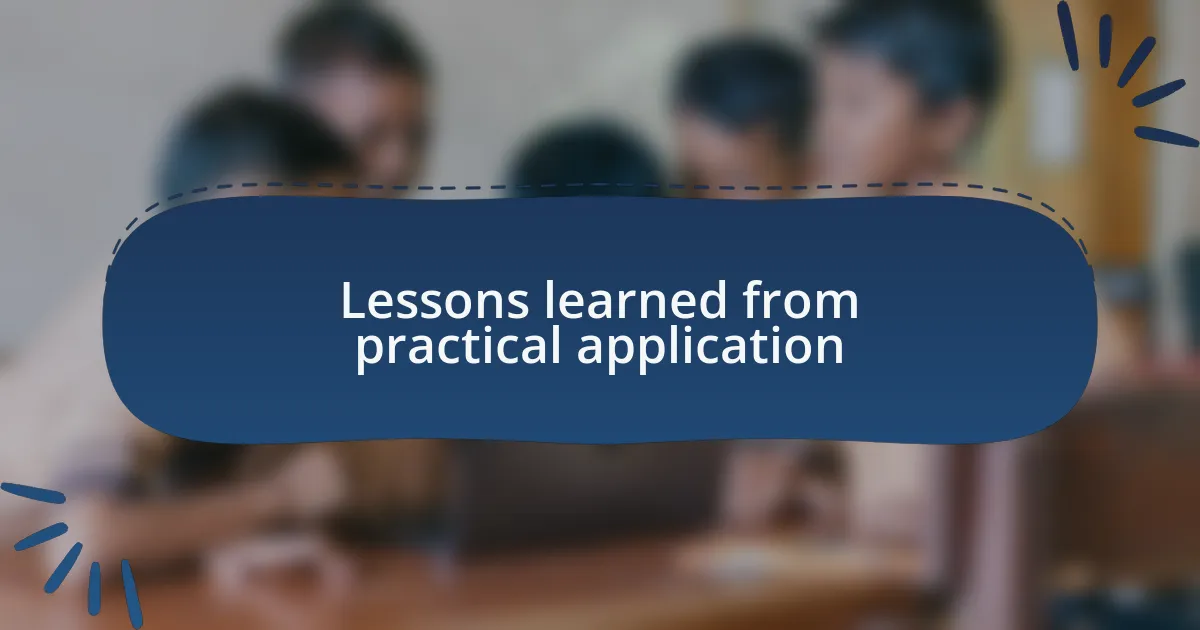
Lessons learned from practical application
When reflecting on the practical application of child safeguarding policies, I recall a training session where we role-played different safeguarding scenarios. Initially, the staff was hesitant, afraid of making mistakes in how they responded to potential issues. But by the end of the session, I saw light bulbs go on as everyone started thinking critically about their roles. Isn’t it fascinating how hands-on experience can demystify complex protocols and build confidence?
I remember a particularly challenging case where a child disclosed concerns about home life. It was after we had integrated our new safeguarding protocols that I witnessed firsthand how empowered our team felt to intervene. They approached the situation with sensitivity and clarity, demonstrating the profound effect that a well-implemented policy can have. Does it not highlight the significance of creating a proactive rather than reactive culture?
Moreover, one of the greatest lessons I learned was the value of feedback loops. After implementing the policy, we established regular check-ins to discuss what was working and what needed adjustment. I was surprised by how candid and insightful the staff became during these discussions, often sharing experiences that could inform future policies. Isn’t it encouraging to realize that ongoing dialogue can lead to continuous improvement in safeguarding measures?
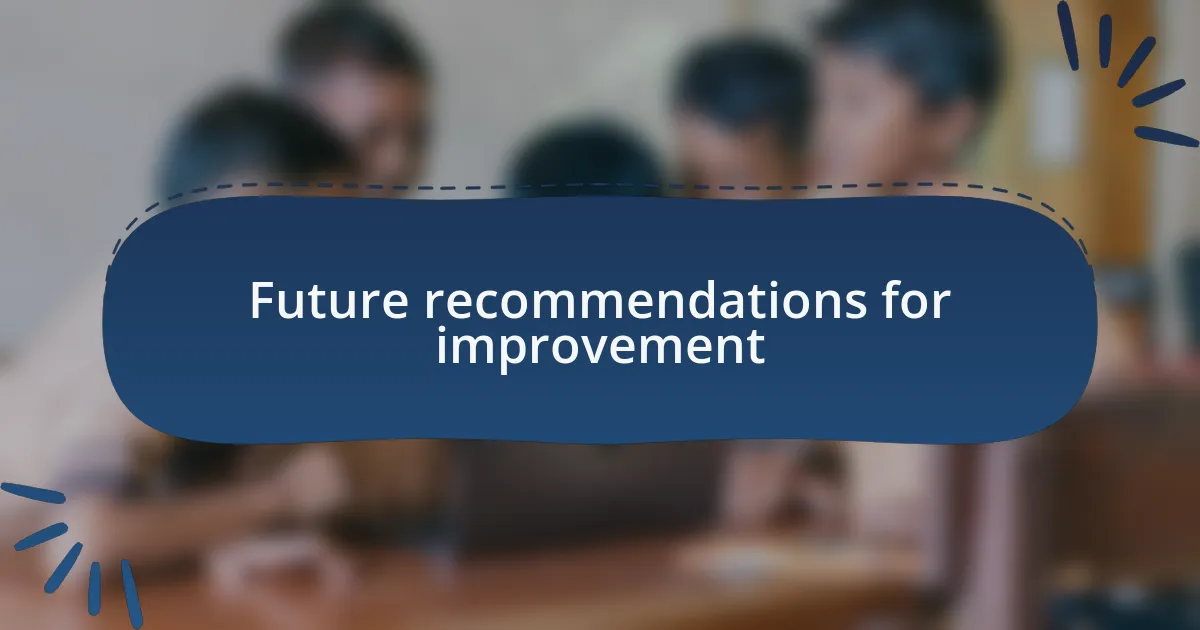
Future recommendations for improvement
To enhance child safeguarding policies, I believe we should prioritize ongoing professional development. In my experience, regular training sessions can foster a deeper understanding of evolving risks and best practices. Have you ever noticed how new insights emerge when we revisit these critical topics? By creating a culture of continuous learning, we can empower our staff to adapt and respond effectively to both new and existing challenges.
Feedback shouldn’t just be a post-implementation afterthought; it should be woven into the very fabric of our safeguarding approach. I recall a time when we asked staff to anonymously submit their experiences with safeguarding measures. The responses were eye-opening, revealing gaps I hadn’t even considered. Why not turn these observations into actionable adjustments that can significantly enhance our policies? By formally integrating feedback channels, we create a dynamic system that values input and constantly evolves.
Lastly, I think we need to engage with the families we serve more directly. I remember a poignant conversation with a parent who shared their hesitations about reporting concerns. Their insights illuminated the barriers families face, often stemming from fear of repercussions. How can we create an environment where families feel safe to voice their concerns? Strengthening relationships with parents can lead to more informed and effective safeguarding practices.